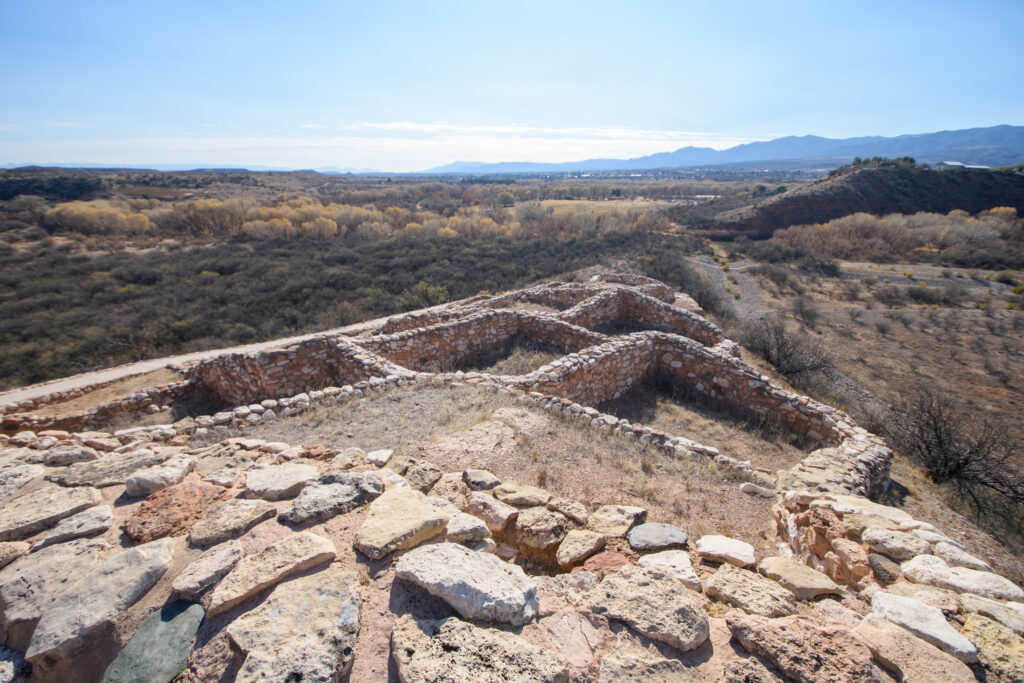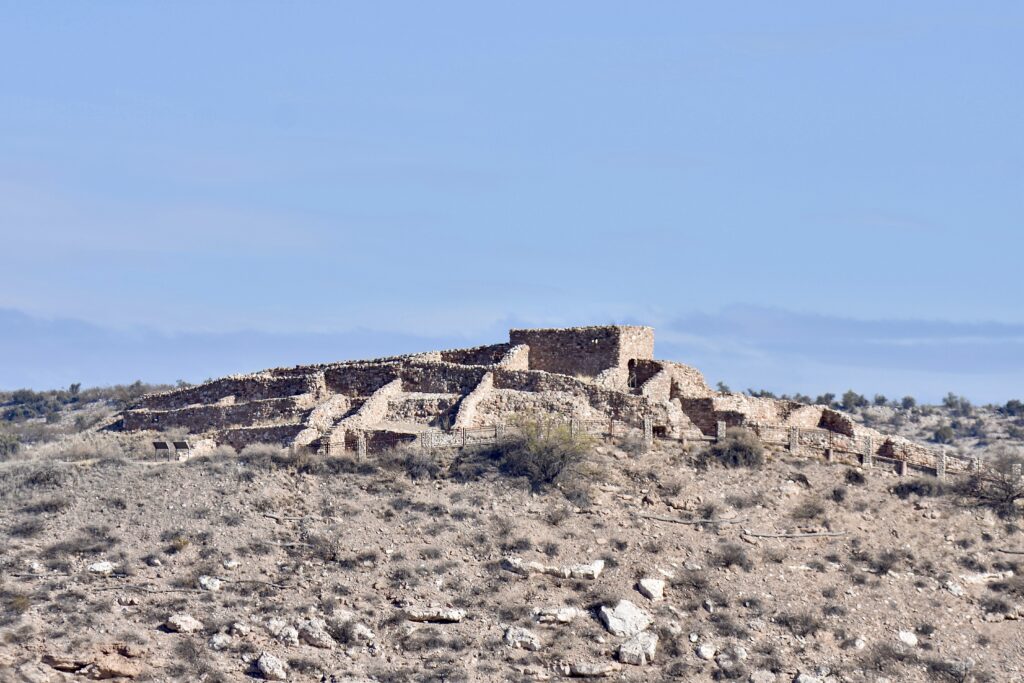
A longstanding question among archaeologists about the Tuzigoot ruins near Cottonwood, Arizona, is where the inhabitants went and why they left. There can be little mystery, however, in the settlers’ initial choice of the spot.
At the base of the hill upon which the settlement was built, flows a spring-fed river, now called the Verde, which provides an easily-accessed and continual source of water. This river, though, served as more than just a reliable water source. Because of the low banks at this point in its course, the many beavers that inhabited it, and the plentiful cottonwood trees with which these beavers dammed its flow, the river was given to regular flooding, which floods covered the large adjacent plain with centuries of deep alluvial soil, just waiting to be brought under the planting stick.
The hill itself sits well above the plain, protected from its floods, and providing a perfect spot for monitoring the entire agricultural space and a 360º view of all the surrounding valley. Moreover, the hill was covered with stones and clay that could easily be gathered and used for building materials, more of which were available in the wood of the cottonwood and sycamore trees growing along side the river.

Socially speaking, the broader valley was inhabited by numerous other people groups who, despite their cultural differences appear to have been living in relative peace, cooperation, and mutual benefit. In short, the site offered just about everything an agriculturally-minded people could ask for.
As for the particular people who decided to settle at Tuzigoot, their precise origin, the language that they spoke, even the name by which they were called at the time, these are all unknown to us. What we do know of them we learn from the archeological artifacts they left behind and from the traditions related by the modern indigenous peoples into whose number Tuzigoot’s inhabitants appear to have been welcomed after their departure from the site.
The artifacts which these people left behind distinguish them culturally from some of the other surrounding peoples who followed more of a hunter-gatherer pattern of life and connect them instead with other groups of agriculturalists whose settlements filled what is now the Verde Valley and stretched as for north as the San Francisco Peaks.
It is the Spanish name for this northern region, Sierra sin Agua (the waterless range) from which archaeologists would later coin for this cultural group (even for those living in far-from-waterless places) the name, Sinagua. The Hopi, who count this culture as part of their own ancestral lineage, call the people Hisat’sinom, or “the ones from long ago.”
Prior to around 550 AD, the Hisat’sinom lived in simple wood-frame pit houses, but for the five hundred years or so preceding the settlement of Tuzigoot (named from the Apache Tú Digiz, crooked water) they had been building stone pueblo structures with wooden roofs.
It is the collection of such structures, begun around 1050 AD, that offers the most visible remainder of the Tuzigoot settlement. The present ruins thereof, which were excavated and partially rebuilt back in the 1930s, represent the architectural footprint at its greatest extent. The pueblo began, however, as a much smaller group of rooms.
Each room of the overall structure had four stone walls, secured and plastered over with mud mortar. Entry to most of these was through holes in their wooden roofs. All the regular rooms contained their own fire pit and grinding stones, indicating that they were used as family dwellings (as opposed to storerooms). A multi-story structure at the summit of the hill may have served as a central storage area. Over the three hundred plus years of the site’s occupation, the complex was expanded to include 110 separate rooms, indicating a steady population growth.
The causes of this growth, as revealed by the non-structural artifacts recovered in the site’s excavation, appear to have been the excellent use that the inhabitants made of the available natural resources. From these other artifacts, we learn a fuller story of these people’s lives.
We see from discarded fibers that they made use of the native prickly pear cactus. They also domesticated wild turkeys, using them primarily for their eggs. From the grains and seeds recovered at the site, we see that they practiced the Three Sisters technique of farming, common among other Hisat’sinom settlements, and also, truth be told, well-represented across the whole North American continent. This threefold planting of corn, beans, and squash alongside of one another provided mutual benefit to each plant and staved off the depletion of soil nutrients which can result from planting crops singly.

In addition to these crops more common to the region for some time, the inhabitants of Tuzigoot also cultivated the rarer cotton, brought more recently from Mexico. This cultivation of cotton, then, indicates connections with tribes far to the south. Other artifacts found on site further reveal far-reaching network of trade. Shells from as far away as the west coast, pottery from the Ancestral Pueblans living to the northwest, and macaw feathers from deep in Mexico indicate trade relationships with peoples living even at great distances. The settlers of Tuzigoot appear also to have received game from the hunter-gatherers living in their more immediate vicinity. This number and variety of goods brought in from places near and far is another indication of the abundance of food that must have been produced at the Tuzigoot site, the excess of which would have been necessary for such extensive importation of goods.
The settlement’s agricultural and economic success is further demonstrated in the evident availability of leisure time for its inhabitants to pursue more aesthetic endeavors. One artifactual example of this is an piece of cotton cloth that displays such intricate artistic design and quality workmanship that it took modern expert weavers several months even to determine the methods by which it could have been produced. The aesthetic sensibilities of the people of Tuzigoot are further exhibited in the many pieces of jewelry found on site which the inhabitants seem to have produced themselves.
What may at first seem an exception to the local taste for finer things appears in the pottery manufactured there. By comparison to the pottery produced by surrounding tribes, Tuzigoot items are rather plain and utilitarian. But this too is merely a testament to the success of their agricultural endeavors, which made beautiful decorative pottery (well represented in the ruins) much easier to obtain by trade than by manufacture.

Such was the state of things in the early 1300s for the inhabitants of Tuzigoot: lots of sustaining food, fine art, and good relations with the surrounding peoples. It was around this time, though, that the annual rains began to slack, and land began to experience what would end up being at fifty-year drought. The settlement continued to expand throughout this time, and even shortly thereafter, but by 1380, there was no one living at the site.
And herein lies the riddle. Why did everyone leave? The drought by itself is insufficient to explain their departure. While the annual floods ceased for a time, the river never ceased to flow, allowing this to remain one of the better agricultural sites to be found in the area. Perhaps the drought made things more difficult for the surrounding hunter-gatherers and strained that formerly cooperative relationship, but this is rendered less likely by evidence that some of the inhabitants actually stayed behind and joined these other groups.

How, then, can the departure of the Tuzigoot people be accounted for? The emigration might best be explained by the people’s religious sensibilities. That some form of religion was practiced by these people is evident from their burial practices. That this religion had some affinity with the practices of the Hopi is suggested by the presence of Hopi ceremonial items among the Tuzigoot artifacts. And for many Hopi, migration, and specifically a final migration to the present Hopi Mesas, was a sacred covenantal duty. From this Hopi perspective, the settlement of Tuzigoot by their Hisat’sinom ancestors was never intended to be permanent. It was but the last stop in a larger spiritual journey which had been going on for centuries. As one Hopi is reported to have said when asked why the Tuzigoot settlers left when they did, “It was just time for them to go.”